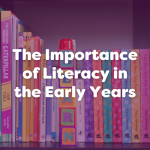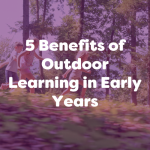Literacy is one of the key areas of the Early Years Foundation Stage and therefore understanding effective ways of promoting literacy in the early years is vital as it sets children up for success in later life from academic success to positive friendships and relationships. In this blog, we cover what Literacy means in the Early Years, touch on barriers to learning and then suggest some ways in which you can promote Literacy in the early years.
What is literacy?
Literacy is defined as the ability to read and write. It is a skill that serves us throughout our lives as it allows us to communicate and understand effectively. In the early years Literacy is important as it is the foundation of academic success and supports social interactions and consequently, the ability to build connections with others. It is a fundamental skill that enables individuals to access information, communicate effectively and make informed decisions.

Literacy in EYFS
In the Early Years Foundation Stages, Literacy is divided up into 3 areas:
- Reading and language comprehension.
Language comprehension is a skill that starts developing from birth. This development begins when adults talk to the child about the world around them, read with them and enjoy the likes of rhymes, poems and songs together
Reading is a skill that develops later on and consists of both the speedy working out of unfamiliar printed word pronunciation (decoding) and speedy recognition of familiar printed words. - Exploring words
- Writing
This involves transcription (i.e spelling and handwriting) and composition (articulating ideas and structuring them before writing)
Barriers to literacy in the early years
Barriers to learning can occur in any area. It is therefore important for early years educators to identify and consider potential barriers to literacy to give children the best opportunities for learning.
Some barriers to consider include:
- Children with additional learning needs.
This may present as an issue if unnoticed or not catered for correctly as these children may struggle to develop at a similar pace to the rest of their cohort. Practitioners must make sure they are offering all children equal opportunity and support where needed. - Disadvantaged backgrounds.
Children who are perhaps underprivileged may struggle due to a lack of access to the correct equipment or material for learning. - Inappropriate equipment or materials.
An example of this could be a practitioner insisting on a particular book that does not match the child’s reading ability. This is likely to result in a lack of motivation from the child and they will disengage from learning. This could further result in an established negative association with reading that will become a long term barrier to literacy and general development.
Ways to promote literacy in the early years
Below are just a handful of ways in which you can remove any barriers to literacy and really facilitate learning in your setting:
- Make a book nook
This is a simple yet effective way to promote literacy – make it accessible and inviting! Your book nook could be as big and as elaborate as you like or as your space allows. A simple place to start is a pile of cushions and a stack of reading options in a quiet and cosy corner. - Ensure you have a range of materials for all abilities
As mentioned previously, it is vital to make sure material is ability appropriate so as not to demotivate a child. In your book nook or dedicated literacy area, make sure to provide a range of resources that are accessible for everyone. Easy accessibility means that the stigma of having to select a less complex story is removed and children have power over their choices which will boost their self-esteem. - Talking prompts
Verbal communication is a vital part of literacy and is so easy to facilitate! This can be done by asking the child questions or providing prompts for the children to speak to one another such as conversation cubes or storytelling cubes.
Another great resource is the “All about me” book as it gets children thinking about the people most familiar to them.

We hope that this blog has helped shed a little more light on such a key area of the EYFS and provided you with tips to promote literacy in the early years. If you would like to share any other tips or recent experiences with us then please tag us in your content or use the hashtag #ExploreWithEYR to start the conversation!





